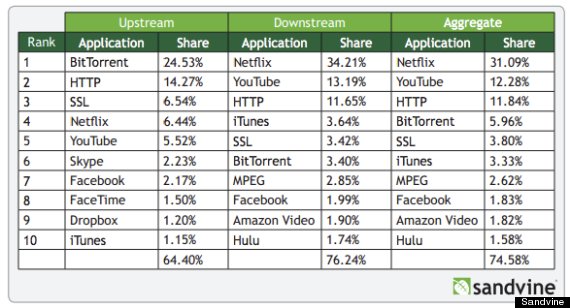Netflix is a data hog. And that hog is growing fatter.
The streaming video service now accounts for a whopping 34.2 percent of Internet traffic sent to North American homes during peak evening hours, according to a new report from Sandvine, a maker of broadband network equipment.
That means that on any given night, when people are at home vegging out on the couch, more than a third of Internet traffic going into North American homes consists of "Breaking Bad," "House of Cards" or other video from Netflix.
Netflix's share of this so-called downstream traffic flowing into homes has increased from November, when it accounted for 31.6 percent at peak times, according to Sandvine's previous Global Internet Phenomena Report, which is released twice each year.
Netflix added more than 2 million subscribers in the U.S. in the first three months of this year, bringing its total subscribers to 35.67 million. But much of Netflix's growing data usage is due to an improvement in the quality of its stream, according to Sandvine. In September, Netflix began streaming some titles in Super HD.
"Super HD content is about 50 percent larger than previous 1080p content Netflix offered," Dan Deeth, the media relations manager for Sandvine, told The Huffington Post. "By offering that content, Netflix streams of the highest quality increased in size dramatically. And that's really one of the main reasons for the spike."
YouTube, iTunes and Amazon video services all were far behind Netflix in data used. HBO Go, which gives HBO subscribers (and, of course, those who have shared passwords -- yes, I'm talking about YOU) access to HBO content on mobile devices, computers and connected TVs, didn't even make the top 10:

The news of Netflix's rising share of Internet traffic comes after the company agreed to pay Comcast and Verizon for direct access to their networks. Some Verizon and Comcast customers had complained for months of slow and poor quality Netflix streams, due to congestion in network infrastructure. Netflix and the ISPs were in a standoff as to who should be responsible to pay to upgrade the infrastructure, and Netflix caved -- at least in the cases of Verizon and Comcast.
Since the deal, Netflix performance on Comcast's network has gotten better, according to data Netflix releases each month. The Netflix agreement with Verizon didn't occur until late April, and any performance change isn't yet reflected in data Netflix releases.
Because these agreements concern connections between Netflix and the ISPs, and not what happens to data once it is already on the ISPs' networks, they would not have violated the 2010 Open Internet, or "net neutrality" rules, which a federal court struck down in January, according to Michael Weinberg, a vice president at Public Knowledge, a consumer advocacy group. Netflix, however, recently pushed for a stronger definition of net neutrality that would include these types of connections.
The Federal Communications Commission -- not without controversy -- will vote this week on an initial plan that may let broadband companies like Comcast and Time Warner Cable charge for a "fast lane" to consumers.
The Sandvine report, chock-full of juicy nuggets, also says there's growing evidence that we are becoming a nation of cord-cutters. The company is unable to determine whether an individual is actually a "cord cutter" -- someone who ditched cable or satellite in favor of Netflix and other services delivered over a broadband connection. But it did find that the top 15 percent of users on "several U.S. networks" use a ton of data, suggesting that they "exhibit cord cutting behavior" and "are likely using streaming as a primary form of entertainment."
This group of broadband subscribers uses a whopping 212 gigabytes of data each month -- more than seven times that of a typical subscriber.

CORRECTION: This post initially said it was unclear whether or not Netflix's agreements with Comcast and Verizon would have violated the 2010 Open Internet order. That is not the case.